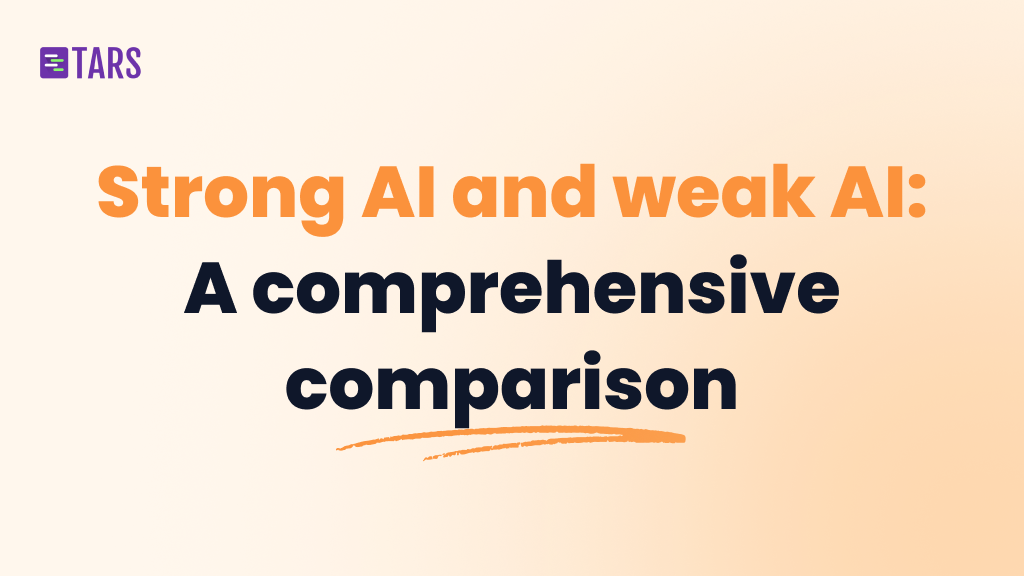Strong AI and weak AI – A comprehensive comparison

Artificial Intelligence (AI) is one of the most exciting fields in technology today, continually pushing the boundaries of what machines can achieve. The debate between strong AI and weak AI centers on the capabilities and limitations of these technologies.
While advancements in AI like ChatGPT are impressive, fears of AI taking over the world continue to exist. A recent survey by the Pew Research Center found that a significant portion of Americans worry about AI becoming too intelligent and a threat to humanity. In fact, strong AI is often held to the standard of human intelligence, aiming to replicate the cognitive capabilities that humans possess—the ability to reason, plan, solve problems, think abstractly, comprehend complex ideas, learn quickly, and learn from experience.
The Turing Test is a way to see if a machine can act as smart as a human. ChatGPT shows abilities that come close to this goal by doing things like:
- Passing the bar exam
- Creating jokes from pictures
- Coding video games that you can play
- Showing creativity in different ways
These achievements highlight how well it can perform various tasks, marking important progress toward achieving human-like intelligence. However, for businesses operating in today’s market, the most practical approach doesn’t involve waiting for Strong AI to materialize fully. Instead, forward-thinking companies are leveraging AI Agent builders that combine the reliability of narrow AI with the advanced problem-solving capabilities of modern generative AI, creating solutions that deliver immediate, measurable business value.
In this article, we will provide a comprehensive comparison of strong AI and weak AI. We’ll examine their characteristics, future implications, and real-world applications. We’ll also explore how AI Agents are transforming business automation.
Weak AI: Today’s limited yet effective solution
Weak AI, also known as narrow AI, is already making a big impact in our daily lives with its highly specialized capabilities. Everyday applications like Siri and Alexa, or the personalized shopping recommendations you see online, are all examples of weak AI at work. These systems excel at performing specific tasks that they’re programmed to do.
However, weak AI does have its limitations. While it can learn from data over time, such as improving its ability to filter spam in your email, it doesn’t learn like humans do. Weak AI can’t apply what it’s learned from one context and adapt it to solve new, unrelated problems. This means its ability to handle more complex, multi-faceted tasks is limited.
In business settings, weak AI is invaluable for solving specific problems. For instance, it can analyze large volumes of data to detect fraudulent transactions, manage customer inquiries through Chatbots, or optimize supply chains.
But the landscape of business automation has evolved dramatically. Modern AI Agents have transformed what’s possible within the realm of narrow AI. Agentic workflows now enable businesses to create sophisticated AI Agents that integrate multiple tools, employ advanced prompting techniques, and offer enhanced configuration options that were unimaginable just a few years ago.
Unlike traditional chatbots that follow rigid, rule-based scripts, today’s AI Agents can handle complex, multi-turn conversations, integrate with various business systems, and adapt their responses based on context and user behavior. This represents a significant leap forward, bridging the gap between the limitations of traditional weak AI and the ambitious goals of strong AI.
Each of these tasks leverages weak AI’s ability to perform repetitive, data-intensive tasks efficiently.
Strong AI: A vision to achieve sci-fi AI intelligence
Strong AI, also known as Artificial General Intelligence (AGI), is a futuristic concept straight out of science fiction. AGI aims to replicate human intelligence, enabling machines to understand and learn from their environment in a way that mimics human thought and reasoning. Unlike weak AI, which excels at specific tasks, AGI would have the capacity to adapt to new situations, identify problems on its own, and create solutions without human input, much like the sci-fi characters TARS from Interstellar and C-3PO from Star Wars.
Currently, we use weak AI for specific business applications like handling customer service inquiries, optimizing supply chains, detecting fraud, etc. These systems are programmed to perform well-defined tasks and can learn from data to improve their performance in these specific areas. However, they cannot transfer their learning to tackle unrelated problems or adapt to completely new environments.
Strong AI, on the other hand, would not only manage these tasks but could also independently identify new efficiency problems in a supply chain or anticipate new forms of fraudulent activity without being explicitly programmed to do so. It would possess an enhanced decision-making capacity that could revolutionize how businesses operate.
Interestingly, today’s AI Agent platforms are creating capabilities that blur the line between weak and strong AI. While individual AI models remain narrow, AI Agents can now reason across different domains, synthesize information from multiple sources, and adapt their behavior based on context, behaviors that start to resemble the flexibility we associate with strong AI. This represents a practical pathway toward more general AI capabilities, achieved not through a single breakthrough but through intelligent orchestration of specialized systems.
While Strong AI remains a dream of the future, the progress in weak AI technologies is laying a promising foundation for its eventual realization. Today’s AI can effectively solve predefined business problems. As technology evolves, we edge closer to developing an AI that can independently identify and solve challenges, driving us towards the era of AGI.
Here’s a table that summarizes the key points and business use-cases for Weak AI and Strong AI:
| Aspect | Weak AI | Strong AI |
|---|---|---|
| Definition | Specializing in specific tasks, operating within a limited context. | Designed to mimic human intelligence, capable of understanding and learning any intellectual task. |
| Learning and Adaptation | Can learn from data within its specific tasks, but cannot transfer this learning to unrelated tasks. | Capable of adapting to new situations and applying knowledge across different contexts. |
| Problem Identification | Operates within predefined parameters; cannot identify new problems. | Can autonomously identify and define new problems without human input. |
| Decision-Making | Decision-making is limited to specific programmed scenarios. | Enhanced decision-making capabilities, similar to human reasoning. |
| Business Use-Cases |
|
|
| Sci-fi Comparison | Lacks the adaptive, general-purpose capabilities seen in sci-fi AI. | Resembles sci-fi characters like TARS from Interstellar and C-3PO from Star Wars, with the ability to think and interact like a human. |
Using AI Agents for effective business problem-solving
Generative AI (e.g., ChatGPT) is the closest we’ve come to unlocking the sci-fi problem-solving abilities of Strong AI. But even this technology is not totally risk-free or ready for customer-facing challenges, as it can still produce errors or even harmful responses in complex real-world scenarios. This is one of the many differences between ChatGPT and tried-and-tested customer-facing automation like Chatbots.
The solution? AI Agents—built for solving specific business problems effectively, by combining the reliability of weak AI with the advanced problem-solving capabilities of Generative AI. This hybrid model ensures that AI systems remain robust and effective while minimizing risks.
What makes modern AI Agents particularly powerful is their ability to maintain guardrails and business logic while leveraging generative AI capabilities. They can access company knowledge bases, integrate with existing tools, and follow predefined escalation paths, ensuring that while they’re more capable than traditional automation, they remain safe and predictable for business use. This represents the next evolution in workflow automation, where intelligence meets reliability.
Let’s just look at customer-facing automation, something that normally demands many resources and human intervention. By maximizing the potential of weak AI, they can create a more powerful digital assistant, one that is capable of:
- Automating a wide variety of interactions
- Enhancing customer experience with personalized and tailored responses
- Being reliable, consistent, and safe
- Helping businesses get data-driven insights for future growth and improvement
At Tars, we’ve used a hybrid approach to give businesses the best of technology today—a custom AI Agent that is tailored to fit their business needs. These hybrid AI Agents are backed by Conversational AI. They are specifically designed to enhance customer and business experiences with features such as self-evaluating AI, easy integration, and No-Code management.
Explore use cases of AI Agents across industries in Finance, Government, Healthcare, and Insurance.
I am a content creator and marketer and a Conversational AI specialist. I enjoy crafting informative content that engages and resonates with my audience. In my spare time, I like to explore the interplay between interactive, visual, and textual storytelling, always aiming to bring new perspectives to my readers.
Recommended Reading: Check Out Our Favorite Blog Posts!

AI Agent builders, we need to have a chat about AI’s gender bias

Time is money, so we created AI Agents that help founders save both!

How to Get Your Startup Idea Validated by Paul Graham or Kevin O’Leary? AI Agent to the Rescue

Our journey in a few numbers
With Tars you can build Conversational AI Agents that truly understand your needs and create intelligent conversations.
years in the conversational AI space
global brands have worked with us
customer conversations automated
countries with deployed AI Agents





